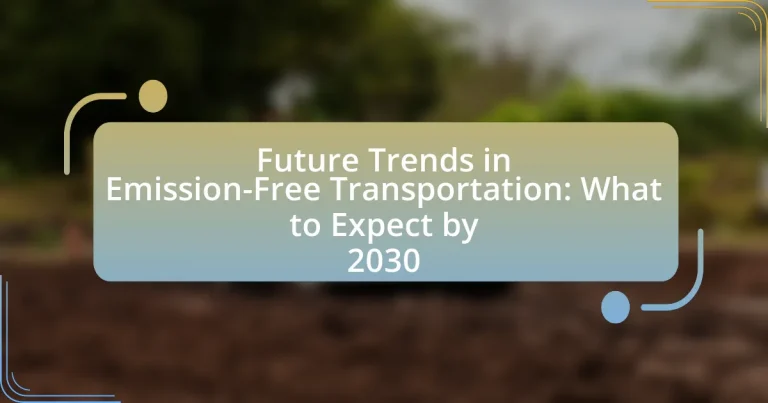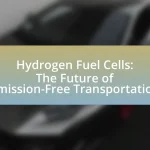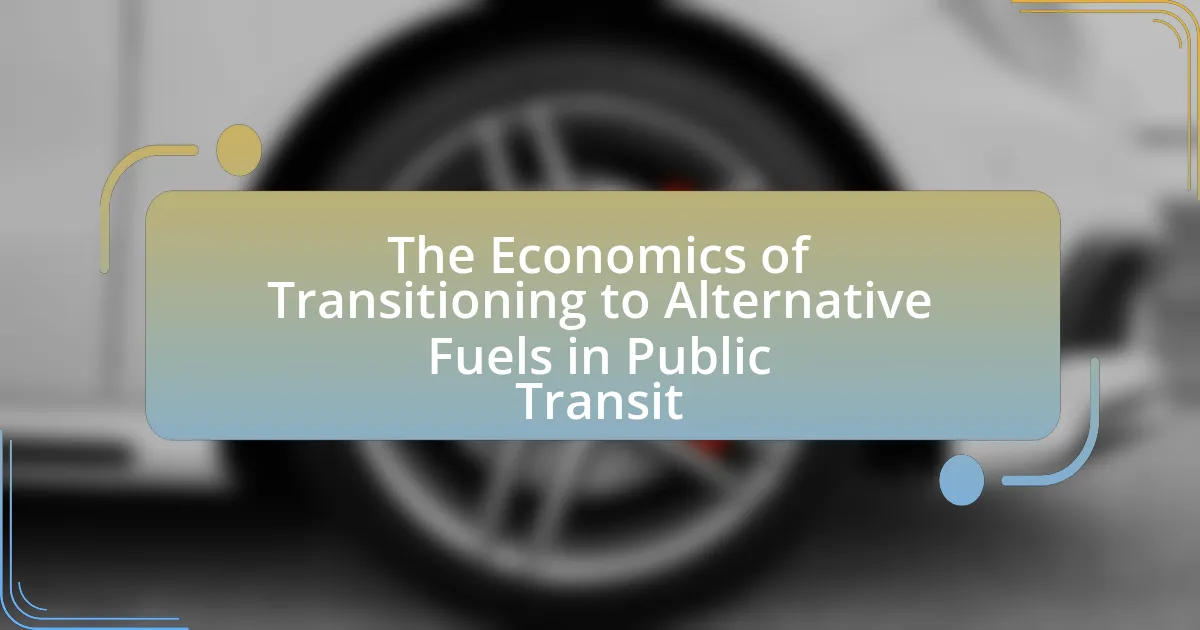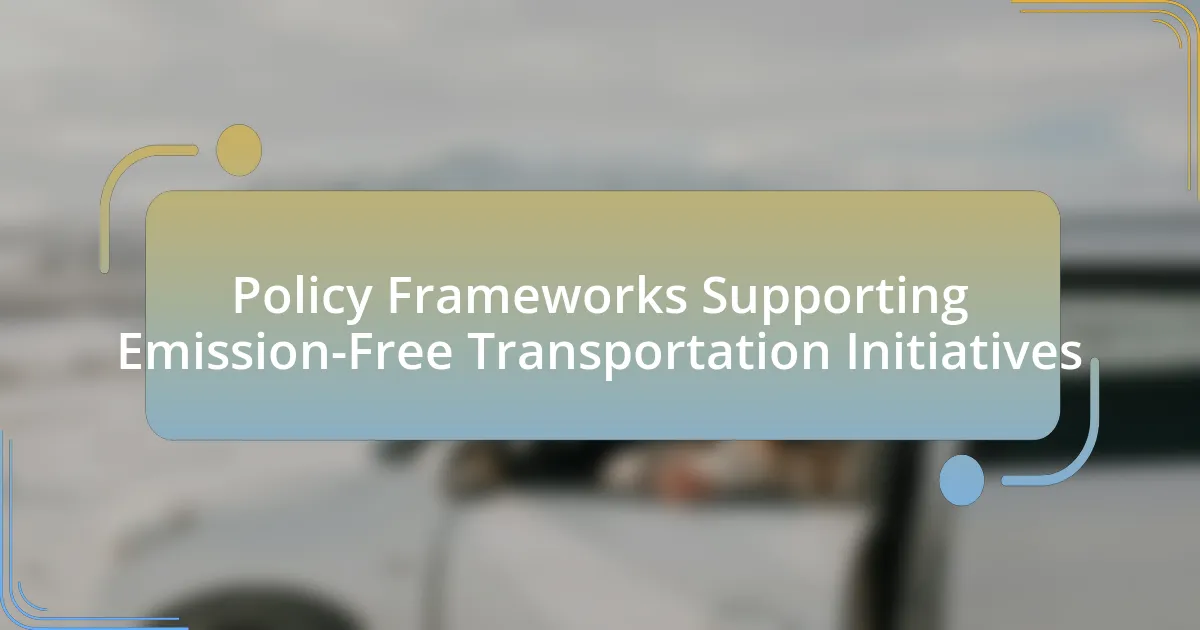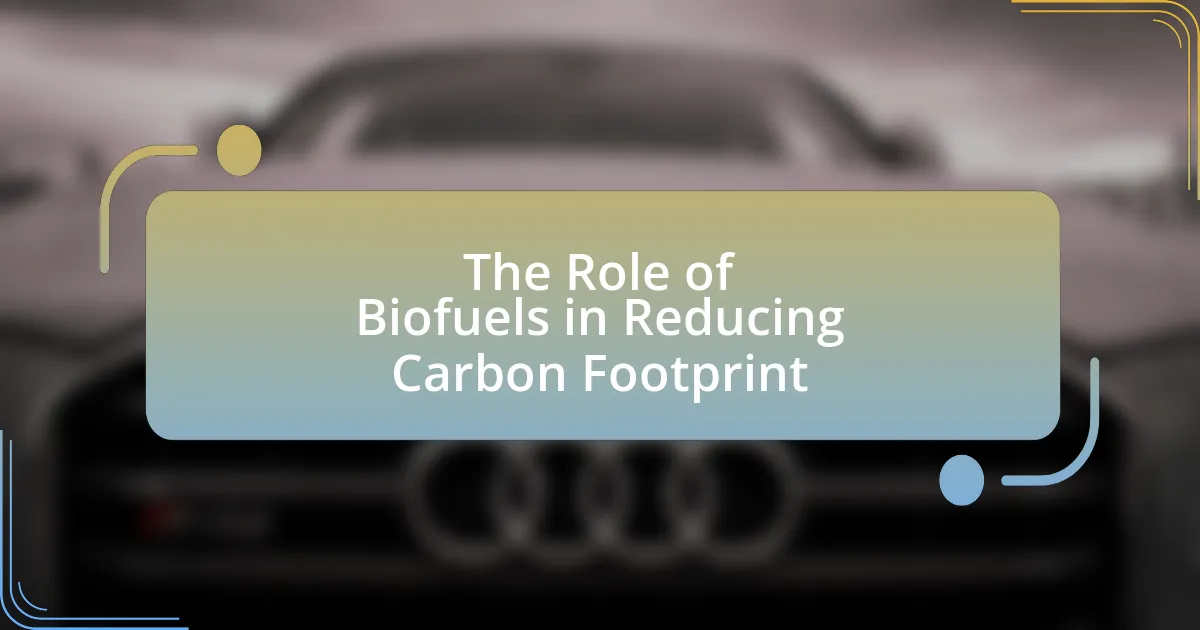The article focuses on the future trends in emission-free transportation, projecting significant advancements by 2030. Key developments include the widespread adoption of electric vehicles (EVs), improvements in hydrogen fuel cell technology, and the integration of autonomous driving systems. It highlights the expected dominance of EVs in the automotive market, the role of government policies and consumer preferences in shaping these trends, and the technological innovations driving the transition. Additionally, the article addresses the challenges facing emission-free transportation, the economic implications of this shift, and the societal benefits, including improved air quality and public health.
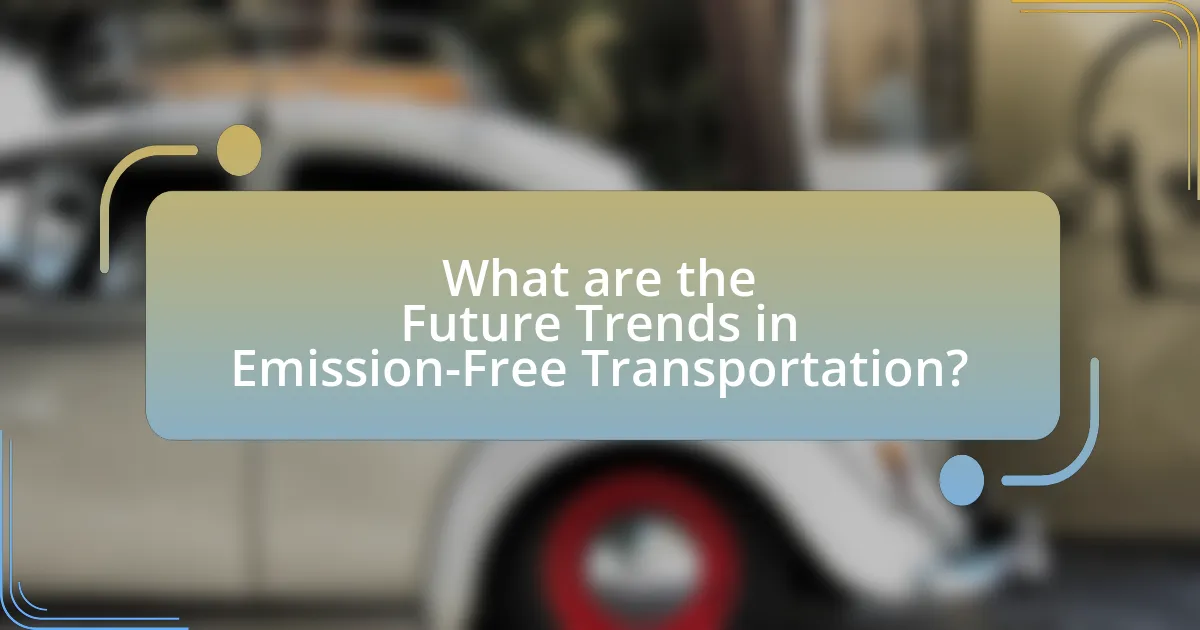
What are the Future Trends in Emission-Free Transportation?
Future trends in emission-free transportation include the widespread adoption of electric vehicles (EVs), advancements in hydrogen fuel cell technology, and the integration of autonomous driving systems. By 2030, it is projected that EVs will dominate the automotive market, with estimates suggesting that over 50% of new car sales will be electric, driven by declining battery costs and increased charging infrastructure. Additionally, hydrogen fuel cells are expected to gain traction in heavy-duty transportation sectors, such as trucking and public transit, due to their quick refueling times and longer ranges compared to battery electric vehicles. Furthermore, the rise of autonomous vehicles will enhance efficiency and reduce emissions by optimizing driving patterns and reducing congestion. These trends are supported by government policies promoting clean energy and significant investments from automotive manufacturers in sustainable technologies.
How is the landscape of transportation expected to change by 2030?
By 2030, the landscape of transportation is expected to shift significantly towards emission-free solutions, primarily driven by advancements in electric vehicle (EV) technology and increased adoption of public transit systems. The International Energy Agency projects that the number of electric cars on the road could reach 145 million by 2030, representing a substantial increase from current figures. Additionally, many cities are implementing policies to enhance public transportation infrastructure, aiming to reduce reliance on personal vehicles and lower greenhouse gas emissions. This transition is supported by government incentives and investments in renewable energy sources, which are crucial for powering these new transportation modes sustainably.
What technological advancements are driving emission-free transportation?
Technological advancements driving emission-free transportation include electric vehicle (EV) technology, hydrogen fuel cells, and advancements in battery storage. Electric vehicles, powered by lithium-ion batteries, have seen significant improvements in range and charging speed, with companies like Tesla leading the market; for instance, Tesla’s Model S can achieve over 400 miles on a single charge. Hydrogen fuel cells convert hydrogen into electricity, offering a fast refueling option and longer ranges, as demonstrated by vehicles like the Toyota Mirai. Additionally, innovations in battery technology, such as solid-state batteries, promise higher energy densities and faster charging times, which are crucial for widespread adoption of emission-free vehicles. These advancements collectively contribute to reducing greenhouse gas emissions in the transportation sector.
How will consumer preferences influence these trends?
Consumer preferences will significantly influence trends in emission-free transportation by driving demand for sustainable options. As consumers increasingly prioritize environmental sustainability, manufacturers will respond by investing in electric vehicles (EVs) and alternative fuel technologies. For instance, a 2021 survey by Deloitte found that 61% of consumers are willing to pay more for a sustainable vehicle, indicating a strong market shift towards greener transportation solutions. This consumer inclination will compel companies to innovate and enhance the availability of emission-free vehicles, ultimately shaping the future landscape of transportation by 2030.
What role do government policies play in shaping emission-free transportation?
Government policies are crucial in shaping emission-free transportation by establishing regulations, incentives, and funding that promote the adoption of clean technologies. For instance, policies such as tax credits for electric vehicle purchases and stringent emissions standards for manufacturers encourage consumers and companies to transition to low-emission alternatives. Additionally, government investments in charging infrastructure and public transportation systems facilitate the accessibility and convenience of emission-free options. According to the International Energy Agency, countries with supportive policies have seen a significant increase in electric vehicle sales, demonstrating the direct impact of government action on market trends.
Which regulations are expected to impact the industry by 2030?
By 2030, regulations such as the European Union’s Green Deal, which aims for a 55% reduction in greenhouse gas emissions by 2030, and California’s Advanced Clean Cars II regulation, mandating that 100% of new passenger vehicle sales be zero-emission by 2035, are expected to significantly impact the emission-free transportation industry. These regulations are designed to accelerate the transition to electric vehicles and promote sustainable transportation solutions, thereby shaping market dynamics and influencing manufacturers’ strategies.
How are incentives for emission-free vehicles evolving?
Incentives for emission-free vehicles are evolving through increased government subsidies, tax credits, and expanded charging infrastructure. For instance, the U.S. federal government offers a tax credit of up to $7,500 for electric vehicle purchases, which has been instrumental in boosting sales. Additionally, many states have introduced their own incentives, such as rebates and grants, to further encourage adoption. The global trend shows that countries like Norway and the Netherlands are leading with aggressive policies, including exemptions from tolls and parking fees, which significantly enhance the attractiveness of emission-free vehicles. These evolving incentives are designed to accelerate the transition to cleaner transportation and meet climate goals.
What are the key challenges facing emission-free transportation?
The key challenges facing emission-free transportation include limited charging infrastructure, high costs of electric vehicles, battery technology limitations, and regulatory hurdles. Limited charging infrastructure restricts the convenience and accessibility of electric vehicles, as evidenced by a 2021 report from the International Energy Agency, which highlighted that only 1.3 million public charging points were available globally, insufficient for the growing number of electric vehicles. High costs of electric vehicles remain a barrier, with the average price of electric cars still higher than traditional vehicles, impacting consumer adoption. Battery technology limitations, such as energy density and recycling issues, hinder the efficiency and sustainability of electric vehicles. Lastly, regulatory hurdles, including inconsistent policies and incentives across regions, complicate the transition to emission-free transportation.
How will infrastructure development affect the adoption of emission-free vehicles?
Infrastructure development will significantly enhance the adoption of emission-free vehicles by providing essential charging and maintenance facilities. The availability of widespread charging stations reduces range anxiety among potential users, making electric vehicles more appealing. For instance, a study by the International Council on Clean Transportation found that increasing the number of public charging stations correlates with higher electric vehicle sales, demonstrating that infrastructure directly influences consumer behavior. Additionally, improved road networks and dedicated lanes for emission-free vehicles can facilitate smoother travel, further incentivizing their use.
What are the economic implications of transitioning to emission-free transportation?
Transitioning to emission-free transportation has significant economic implications, including reduced operational costs, job creation in new sectors, and potential shifts in energy markets. The operational costs for electric vehicles are generally lower than for traditional gasoline vehicles, with electric vehicles costing about 60% less to maintain and operate over their lifetime, according to the U.S. Department of Energy. Additionally, the transition is expected to create approximately 1.3 million jobs in the clean energy sector by 2030, as reported by the International Renewable Energy Agency. Furthermore, the shift towards renewable energy sources for transportation can lead to decreased dependence on fossil fuels, impacting global oil markets and potentially stabilizing energy prices.
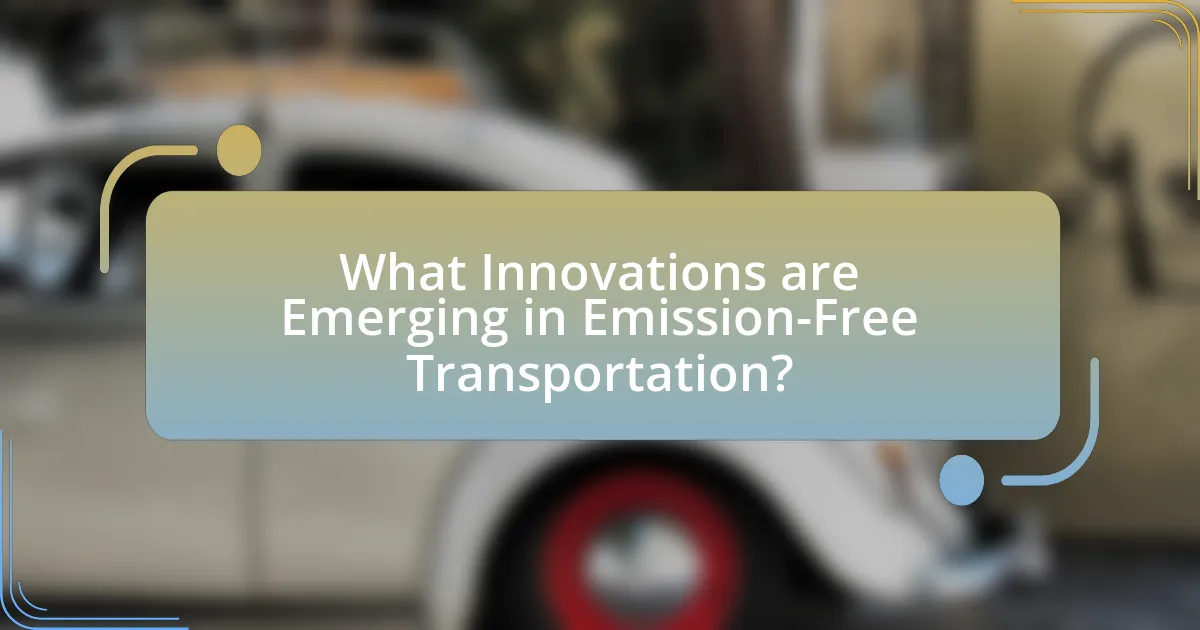
What Innovations are Emerging in Emission-Free Transportation?
Innovations emerging in emission-free transportation include advancements in electric vehicle (EV) technology, hydrogen fuel cells, and autonomous electric public transport systems. Electric vehicles are increasingly utilizing solid-state batteries, which offer higher energy density and faster charging times compared to traditional lithium-ion batteries. According to a report by the International Energy Agency, global electric car sales reached 6.6 million in 2021, indicating a significant shift towards EV adoption. Hydrogen fuel cells are gaining traction as they provide a longer range and quicker refueling compared to battery electric vehicles, with companies like Toyota and Hyundai leading the development of hydrogen-powered cars. Additionally, cities are investing in autonomous electric buses and shuttles, which are designed to reduce emissions and improve urban mobility. These innovations collectively contribute to the goal of achieving zero-emission transportation by 2030.
How are electric vehicles evolving in the next decade?
Electric vehicles (EVs) are expected to evolve significantly in the next decade through advancements in battery technology, increased range, and enhanced charging infrastructure. Battery technology is projected to improve with solid-state batteries, which offer higher energy density and faster charging times, potentially increasing the average range of EVs to over 400 miles on a single charge by 2030. Additionally, the global charging network is anticipated to expand, with the installation of ultra-fast charging stations becoming more widespread, reducing charging times to under 15 minutes for most vehicles. According to a report by the International Energy Agency, the number of public charging points is expected to reach 10 million by 2030, supporting the growing adoption of EVs. Furthermore, automakers are increasingly committing to electrification, with major companies like Ford and General Motors planning to invest over $100 billion in EV development by 2025, indicating a strong shift towards emission-free transportation.
What advancements in battery technology can we expect?
Advancements in battery technology will include solid-state batteries, which promise higher energy density and improved safety compared to traditional lithium-ion batteries. Solid-state batteries utilize a solid electrolyte instead of a liquid one, reducing the risk of leaks and fires while potentially increasing energy capacity by 50% or more. Additionally, researchers are focusing on lithium-sulfur and sodium-ion batteries, which could offer lower costs and greater sustainability. For instance, lithium-sulfur batteries can theoretically provide five times the energy density of lithium-ion batteries, making them a compelling option for electric vehicles. These advancements are supported by ongoing research and development efforts from companies and institutions, aiming to enhance battery performance and reduce environmental impact by 2030.
How will charging infrastructure improve for electric vehicles?
Charging infrastructure for electric vehicles will improve through increased investment in fast-charging stations and the expansion of charging networks. Governments and private companies are committing billions of dollars to enhance the availability and speed of charging options, with initiatives like the U.S. government’s plan to install 500,000 charging stations by 2030. This expansion aims to reduce range anxiety among consumers and facilitate the transition to electric vehicles. Additionally, advancements in charging technology, such as ultra-fast chargers capable of delivering 350 kW, will significantly decrease charging times, making electric vehicles more convenient for users.
What alternative fuels are gaining traction in the transportation sector?
Alternative fuels gaining traction in the transportation sector include electric power, hydrogen, biodiesel, and renewable natural gas. Electric power is increasingly utilized due to advancements in battery technology, with global electric vehicle sales reaching over 6.6 million units in 2021, reflecting a 108% increase from the previous year. Hydrogen fuel cells are being adopted for their efficiency and zero emissions, with investments in hydrogen infrastructure growing, particularly in Europe and Japan. Biodiesel, derived from renewable resources, is being integrated into existing diesel engines, contributing to reduced greenhouse gas emissions. Renewable natural gas, produced from organic waste, is also gaining popularity as a cleaner alternative to fossil fuels, with its use in heavy-duty vehicles expanding significantly.
How do hydrogen fuel cells compare to electric vehicles?
Hydrogen fuel cells and electric vehicles (EVs) differ primarily in their energy sources and operational mechanisms. Hydrogen fuel cells generate electricity through a chemical reaction between hydrogen and oxygen, producing only water as a byproduct, while electric vehicles rely on batteries that store electrical energy for propulsion.
In terms of efficiency, hydrogen fuel cells can achieve a higher range and faster refueling times compared to battery electric vehicles, which typically require longer charging periods. For instance, hydrogen fuel cell vehicles can refuel in about 3-5 minutes, while EVs may take 30 minutes to several hours depending on the charging infrastructure.
However, electric vehicles currently dominate the market due to the widespread availability of charging stations and advancements in battery technology, which have significantly improved their range and performance. As of 2023, the global electric vehicle market is expanding rapidly, with sales surpassing 10 million units in 2022, while hydrogen fuel cell vehicles remain a niche segment with around 30,000 units sold in the same year.
Thus, while hydrogen fuel cells offer advantages in refueling speed and range, electric vehicles are more prevalent and supported by existing infrastructure, making them more accessible to consumers at this time.
What role will biofuels play in emission-free transportation?
Biofuels will play a significant role in emission-free transportation by providing a renewable alternative to fossil fuels, thereby reducing greenhouse gas emissions. Specifically, biofuels such as ethanol and biodiesel can be produced from organic materials, which can lead to a lower carbon footprint compared to traditional fuels. According to the U.S. Department of Energy, biofuels can reduce lifecycle greenhouse gas emissions by up to 86% compared to gasoline. This reduction is crucial for achieving emission targets and transitioning to sustainable transportation systems by 2030.
What impact will autonomous vehicles have on emission-free transportation?
Autonomous vehicles will significantly enhance emission-free transportation by optimizing driving patterns and reducing energy consumption. These vehicles utilize advanced algorithms and sensors to improve traffic flow, which can lead to decreased fuel usage and lower emissions. For instance, studies indicate that autonomous vehicles can reduce energy consumption by up to 20% through efficient route planning and smoother acceleration and braking. Additionally, the integration of electric autonomous vehicles into transportation systems can further decrease reliance on fossil fuels, contributing to a more sustainable future.
How can self-driving technology contribute to reducing emissions?
Self-driving technology can significantly reduce emissions by optimizing driving patterns and improving traffic flow. Autonomous vehicles utilize advanced algorithms to maintain optimal speeds, reduce unnecessary acceleration and braking, and minimize idling, which collectively leads to lower fuel consumption. According to a study by the Institute of Transportation Studies at UC Berkeley, self-driving cars could reduce greenhouse gas emissions by up to 60% by 2030 through enhanced efficiency and reduced congestion. Additionally, the integration of electric self-driving vehicles further amplifies this effect, as electric cars produce zero tailpipe emissions, contributing to cleaner air and a decrease in overall carbon footprint.
What are the safety and regulatory considerations for autonomous vehicles?
Safety and regulatory considerations for autonomous vehicles include ensuring the technology meets safety standards, compliance with traffic laws, and addressing liability issues in case of accidents. Autonomous vehicles must undergo rigorous testing and validation to demonstrate their ability to operate safely in various conditions, as mandated by regulatory bodies like the National Highway Traffic Safety Administration (NHTSA) in the United States. Additionally, regulations must address data privacy concerns related to the collection and use of data generated by these vehicles. The establishment of clear liability frameworks is essential to determine responsibility in the event of a malfunction or accident, which is critical for public acceptance and trust in autonomous technology.
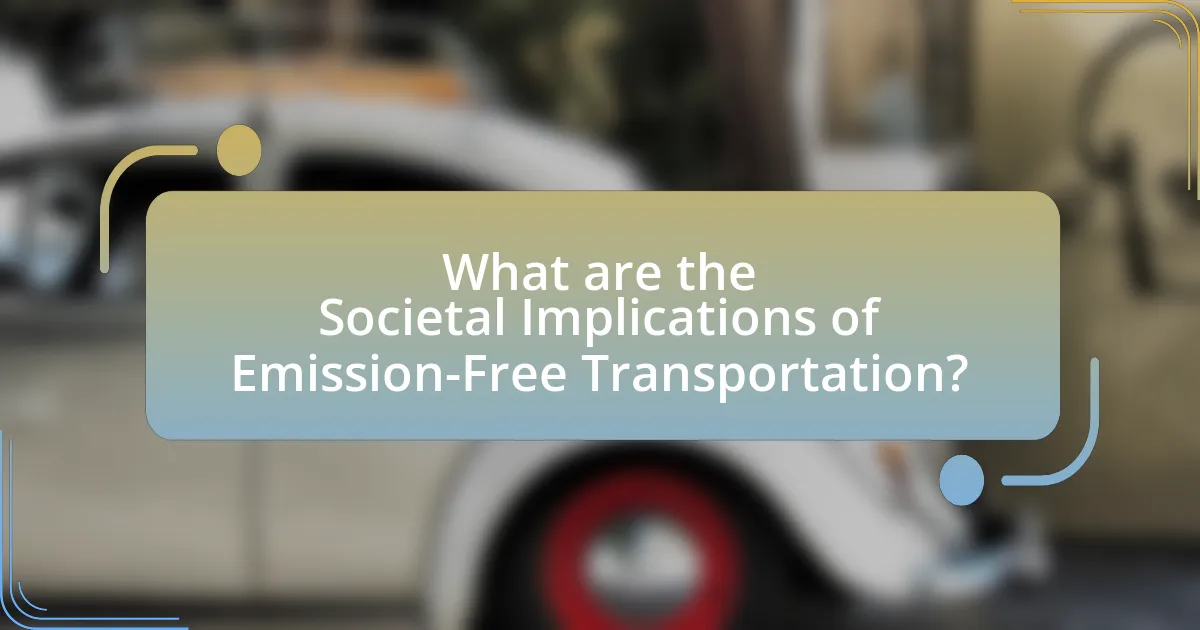
What are the Societal Implications of Emission-Free Transportation?
Emission-free transportation significantly reduces air pollution and greenhouse gas emissions, leading to improved public health and environmental sustainability. Studies indicate that transitioning to electric vehicles can decrease urban air pollutants by up to 80%, which directly correlates with lower rates of respiratory diseases and other health issues. Furthermore, the shift towards emission-free transportation fosters economic growth through the creation of green jobs in manufacturing, infrastructure development, and maintenance of electric vehicle technologies. This transition also promotes social equity by making clean transportation options more accessible to underserved communities, thereby enhancing mobility and reducing transportation costs. Overall, the societal implications encompass health benefits, economic opportunities, and increased equity in transportation access.
How will emission-free transportation affect urban planning?
Emission-free transportation will significantly reshape urban planning by prioritizing sustainable infrastructure and reducing reliance on fossil fuels. Cities will likely integrate more electric vehicle charging stations, dedicated lanes for public transit, and pedestrian-friendly spaces, promoting a shift towards eco-friendly mobility options. Research indicates that cities adopting emission-free transportation strategies can reduce greenhouse gas emissions by up to 80% by 2050, as outlined in the “Global EV Outlook 2023” report by the International Energy Agency. This transition will necessitate re-evaluating land use, zoning regulations, and transportation networks to accommodate cleaner technologies and enhance urban livability.
What changes can we expect in public transportation systems?
Public transportation systems are expected to undergo significant changes by 2030, primarily focusing on electrification and the integration of smart technologies. Many cities are transitioning to electric buses and trains to reduce greenhouse gas emissions, with the International Energy Agency reporting that electric public transport options could account for over 50% of total public transport by 2030. Additionally, the implementation of real-time data analytics and mobile applications will enhance user experience and operational efficiency, as evidenced by cities like Los Angeles and Singapore, which have successfully integrated smart technologies to optimize routes and schedules. These advancements aim to create more sustainable, efficient, and user-friendly public transportation systems.
How will emission-free transportation influence community design?
Emission-free transportation will significantly influence community design by promoting the development of walkable, bike-friendly, and transit-oriented environments. As cities adopt electric vehicles and public transportation systems, urban planners will prioritize reducing reliance on cars, leading to the creation of mixed-use spaces that encourage social interaction and accessibility. For instance, cities like Amsterdam and Copenhagen have successfully integrated cycling infrastructure, resulting in reduced traffic congestion and improved air quality. This shift not only enhances public health but also fosters sustainable economic growth by attracting businesses and residents who value eco-friendly living.
What are the environmental benefits of transitioning to emission-free transportation?
Transitioning to emission-free transportation significantly reduces greenhouse gas emissions, which are a primary driver of climate change. By eliminating tailpipe emissions, vehicles powered by electricity or hydrogen contribute to improved air quality, leading to better public health outcomes. For instance, a study by the Union of Concerned Scientists found that electric vehicles produce, on average, 50% fewer emissions over their lifetime compared to conventional gasoline vehicles, even when accounting for electricity generation. Additionally, emission-free transportation reduces reliance on fossil fuels, promoting energy independence and sustainability. This shift not only mitigates environmental degradation but also supports the transition to renewable energy sources, further enhancing ecological benefits.
How will air quality improve with reduced emissions?
Air quality will improve with reduced emissions by decreasing the concentration of pollutants such as nitrogen oxides, particulate matter, and volatile organic compounds in the atmosphere. These pollutants are primarily released from vehicles and industrial sources; thus, reducing emissions directly lowers their levels. For instance, a study by the Environmental Protection Agency indicates that transitioning to electric vehicles can reduce nitrogen oxide emissions by up to 90% compared to traditional gasoline vehicles. This reduction leads to fewer respiratory issues, improved public health, and enhanced overall environmental quality.
What impact will this transition have on climate change mitigation?
The transition to emission-free transportation will significantly enhance climate change mitigation by reducing greenhouse gas emissions from the transportation sector, which is responsible for approximately 14% of global emissions. This shift towards electric vehicles and alternative fuels is projected to decrease carbon dioxide emissions by up to 70% by 2030, according to the International Energy Agency. Furthermore, the adoption of sustainable transportation technologies will contribute to improved air quality and public health, reinforcing the overall effectiveness of climate action strategies.
What are the economic opportunities associated with emission-free transportation?
Emission-free transportation presents significant economic opportunities, including job creation, cost savings, and market growth. The transition to electric vehicles and alternative fuels is projected to create over 1.3 million jobs in the United States by 2030, as reported by the International Council on Clean Transportation. Additionally, businesses and consumers can save on fuel and maintenance costs, with electric vehicles typically costing less to operate than traditional gasoline vehicles. The global market for electric vehicles is expected to reach $800 billion by 2027, indicating substantial investment potential and economic growth in this sector.
How will job markets evolve in the context of new transportation technologies?
Job markets will evolve significantly due to new transportation technologies, particularly through the creation of jobs in electric vehicle manufacturing, infrastructure development, and maintenance of autonomous systems. As the demand for emission-free transportation increases, industries will require skilled workers to design, produce, and maintain electric vehicles, which is projected to grow by 20% from 2020 to 2030 according to the Bureau of Labor Statistics. Additionally, the expansion of charging infrastructure will necessitate a workforce skilled in installation and maintenance, further driving job creation. The rise of autonomous vehicles will also lead to new roles in software development and data analysis, as companies seek to optimize these technologies. Overall, the shift towards sustainable transportation will not only create new job opportunities but also require retraining of existing workers to adapt to these technological advancements.
What industries are likely to benefit from the shift to emission-free transportation?
The industries likely to benefit from the shift to emission-free transportation include automotive manufacturing, renewable energy, battery production, and public transportation. Automotive manufacturing will see increased demand for electric vehicles, which are projected to make up 30% of global vehicle sales by 2030, according to the International Energy Agency. Renewable energy sectors will expand as the need for clean energy sources to power electric vehicles grows, with investments in solar and wind energy expected to rise significantly. Battery production will also experience growth, as the global market for lithium-ion batteries is anticipated to reach $129 billion by 2027, driven by the demand for electric vehicles. Lastly, public transportation systems are likely to modernize with electric buses and trains, enhancing urban mobility and reducing emissions, aligning with city initiatives to improve air quality and sustainability.
What practical steps can individuals take to support emission-free transportation?
Individuals can support emission-free transportation by adopting electric vehicles (EVs), utilizing public transportation, biking, walking, and carpooling. Transitioning to EVs reduces reliance on fossil fuels, as they produce zero tailpipe emissions. Public transportation systems, such as buses and trains, are generally more energy-efficient per passenger mile compared to individual car travel, thus lowering overall emissions. Biking and walking not only eliminate emissions but also promote healthier lifestyles. Carpooling decreases the number of vehicles on the road, leading to reduced traffic congestion and lower emissions. According to the U.S. Department of Energy, EVs can reduce greenhouse gas emissions by up to 50% compared to conventional vehicles, highlighting the effectiveness of these practical steps.
